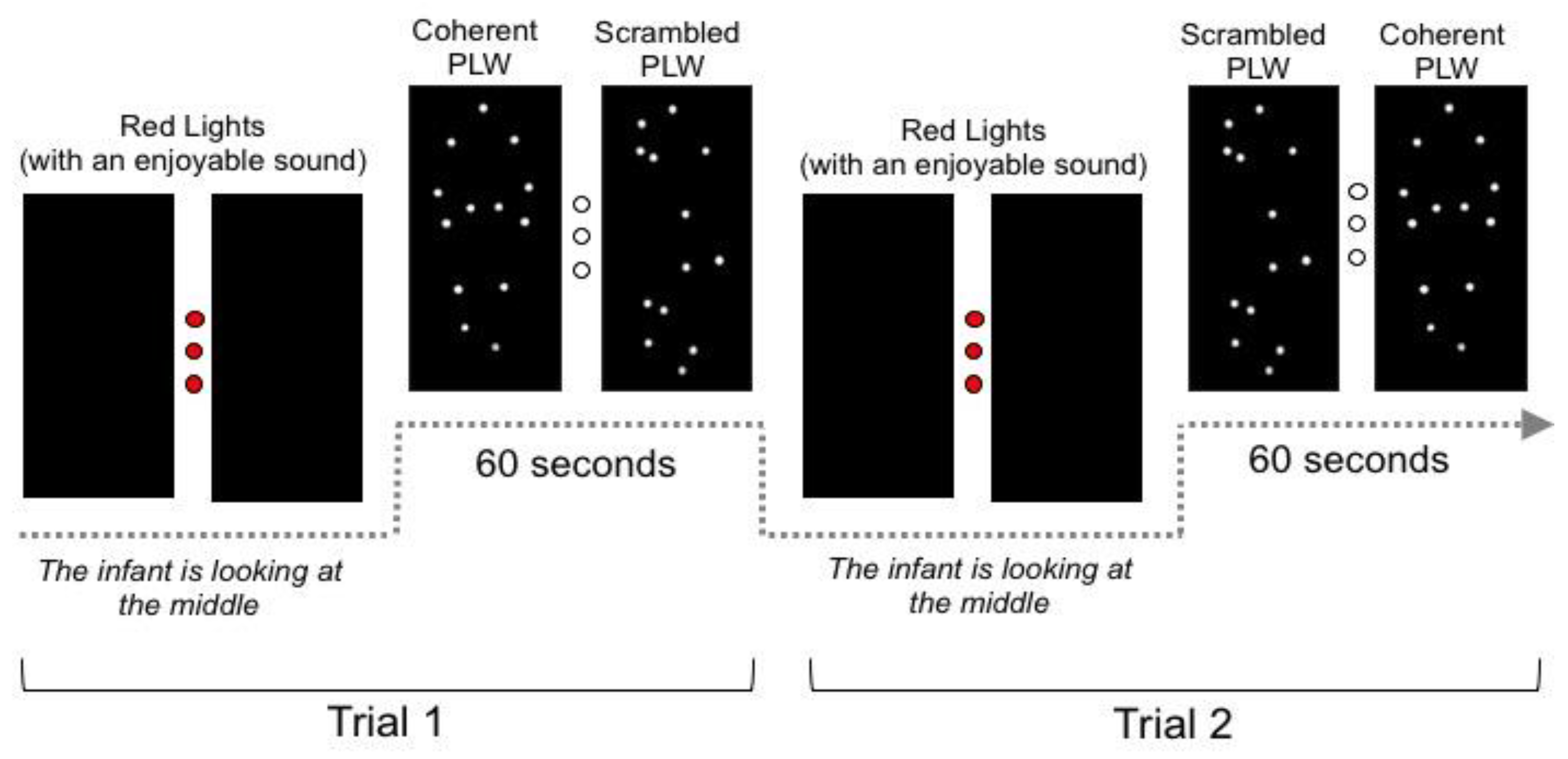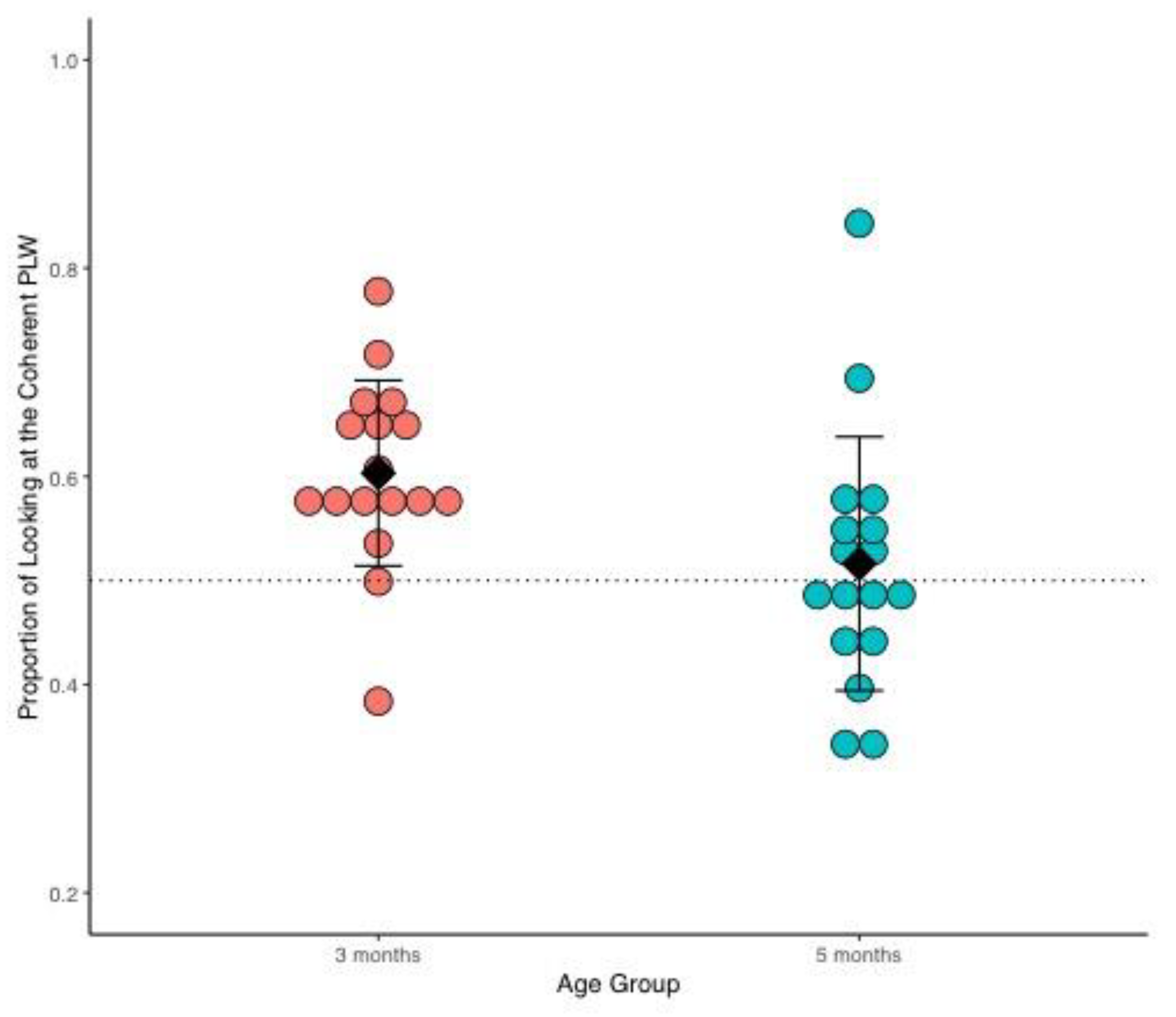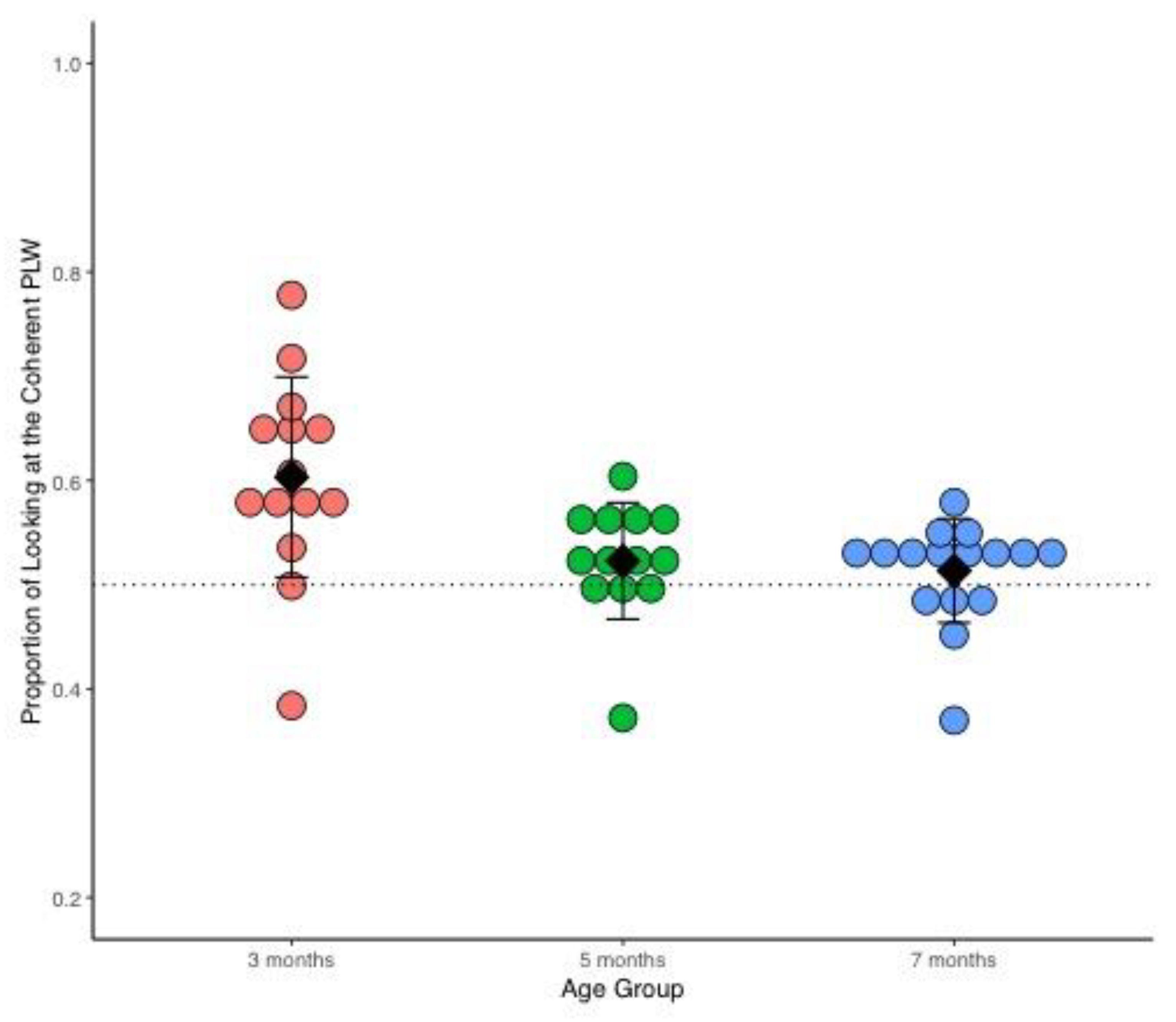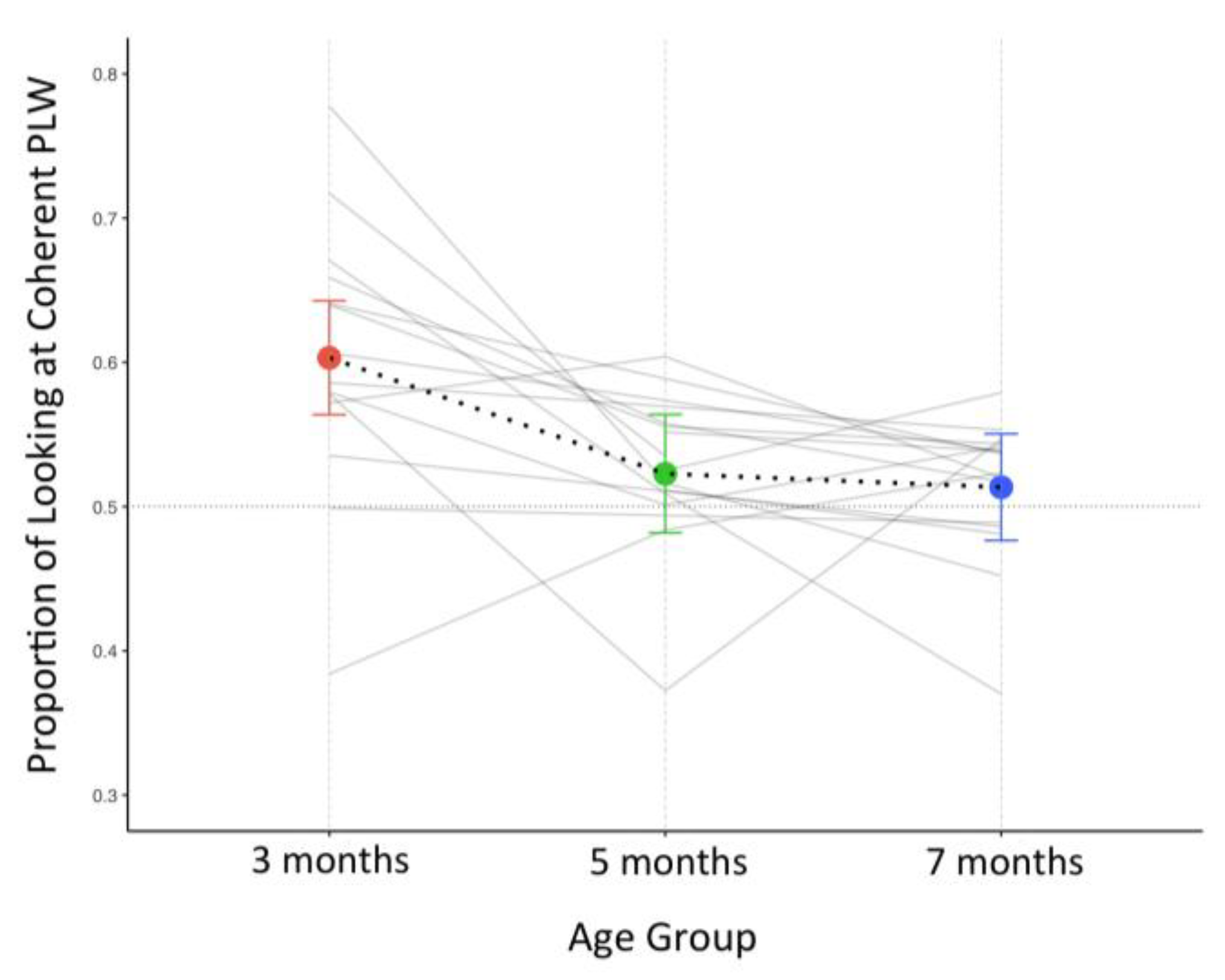Three Months-Old’ Preferences for Biological Motion Configuration and Its Subsequent Decline
Abstract
1. Introduction
1.1. Background
1.1.1. When Infants Begin to Perceive Configural Relations in Biological Motion
1.1.2. Preferential Attention to Biological Motion in the First Year
1.2. Current Experiments: When Do Infants Prefer Biological Motion Configuration?
2. Experiment 1: Cross-Sectional Study with 3- and 5-Month-Old Infants
2.1. Method
2.1.1. Participants
2.1.2. Stimuli
2.1.3. Procedure
2.1.4. Data Coding and Processing
2.2. Results
2.2.1. Comparison to Chance Level
2.2.2. Comparison between Age Groups
2.3. Discussion
2.3.1. Three-Month-Old Infants Prefer the Coherent Point-Light Walker
2.3.2. Five-Month-Old Infants Reveal No Systematic Preferences
3. Experiment 2: Longitudinal Study with 3-, 5- and 7-Month-Old Infants
3.1. Methods
3.1.1. Participants
3.1.2. Stimuli
3.1.3. Procedure
3.1.4. Data Coding and Processing
3.2. Results
3.2.1. Comparison to Chance Level
3.2.2. Comparison between the Three Age Groups
3.2.3. Comparison of Five-Month-Old Infants’ Looking Data in Experiment 1 and Experiment 2
3.3. Discussion
3.3.1. Five-Month-Old Infants Reveal No Systematic Preferences Both in Experiment 1 and 2
3.3.2. Decline in Preference for the Coherent Point-Light Walker in the Older Infants
3.3.3. Developmental Shift between 3 and 5 Months of Age in Biological Motion Perception
4. Final Conclusions and Future Directions
Supplementary Materials
Author Contributions
Funding
Institutional Review Board Statement
Informed Consent Statement
Acknowledgments
Conflicts of Interest
References
- Atzil, S.; Gao, W.; Fradkin, I.; Barrett, L.F. Growing a social brain. Nat. Hum. Behav. 2018, 2, 624–636. [Google Scholar] [CrossRef] [PubMed]
- Kretch, K.S.; Adolph, K.E. Active vision in passive locomotion: Real-world free viewing in infants and adults. Dev. Sci. 2014, 18, 736–750. [Google Scholar] [CrossRef] [PubMed]
- Kuhl, P.K. Early linguistic experience and phonetic perception: Implications for theories of developmental speech perception. J. Phon. 1993, 21, 125–139. [Google Scholar] [CrossRef]
- Werker, J.F.; Hensch, T.K. Critical periods in speech perception: New directions. Annu. Rev. Psychol. 2015, 66, 173–196. [Google Scholar] [CrossRef]
- Simion, F.; Di Giorgio, E. Face perception and processing in early infancy: Inborn predispositions and developmental changes. Front. Psychol. 2015, 6, 969. [Google Scholar] [CrossRef]
- Bardi, L.; Regolin, L.; Simion, F. Biological motion preference in humans at birth: Role of dynamic and configural properties. Dev. Sci. 2010, 14, 353–359. [Google Scholar] [CrossRef]
- Simion, F.; Regolin, L.; Bulf, H. A predisposition for biological motion in the newborn baby. Proc. Natl. Acad. Sci. USA 2008, 105, 809–813. [Google Scholar] [CrossRef]
- Simion, F.; Di Giorgio, E.; Bardi, L. The processing of social stimuli in early infancy: From faces to biological motion perception. Gene Expr. Neurobiol. Behav. Hum. Brain Dev. Dev. Disord. 2011, 189, 173. [Google Scholar]
- Hoehl, S.; Bertenthal, B.I. An interactionist perspective on the development of coordinated social attention. Adv. Child Dev. Behav. 2021, 61, 1–41. [Google Scholar] [CrossRef]
- Johnson, M.H. Interactive specialization: A domain-general framework for human functional brain development? Dev. Ment. Cogn. Neurosci. 2011, 1, 7–21. [Google Scholar] [CrossRef]
- Slater, A.; Johnson, M.H.; Morton, J. Biology and Cognitive Development: The Case of Face Recognition; Blackwell Scientific Publications: Oxford, UK, 1993. [Google Scholar]
- Simion, F.; Turati, C.; Valenza, E.; Leo, I. The emergence of cognitive specialization in infancy: The case of face preference. Atten. Perform. XXI Processes Change Brain Cogn. Dev. 2006, 189–208. [Google Scholar]
- Geldart, S.; Mondloch, C.J.; Maurer, D.; De Schonen, S.; Brent, H.P. The effect of early visual deprivation on the development of face processing. Dev. Sci. 2002, 5, 490–501. [Google Scholar] [CrossRef]
- Mondloch, C.J.; Segalowitz, S.J.; Lewis, T.L.; Dywan, J.; Le Grand, R.; Maurer, D. The effect of early visual deprivation on the development of face detection. Dev. Sci. 2013, 16, 728–742. [Google Scholar] [CrossRef] [PubMed]
- Viola Macchi, C.; Turati, C.; Simion, F. Can a nonspecific bias toward top-heavy patterns explain newborns’ face preference? Psychol. Sci. 2004, 15, 379–383. [Google Scholar] [CrossRef]
- Johansson, G. Visual perception of biological motion and a model for its analysis. Percept. Psychophys. 1973, 14, 201–211. [Google Scholar] [CrossRef]
- Bertenthal, B.I. Infants’ perception of biomechanical motions: Intrinsic image and knowledge-based constraints. Vis. Per-Ception Cogn. Infancy 1993, 21, 175–214. [Google Scholar]
- Bertenthal, B.I.; Proffitt, D.R.; Cutting, J.E. Infant sensitivity to figural coherence in biomechanical motions. J. Exp. Child Psychol. 1984, 37, 213–230. [Google Scholar] [CrossRef]
- Bertenthal, B.I.; Proffitt, D.R.; Kramer, S.J. Perception of biomechanical motions by infants: Implementation of various processing constraints. J. Exp. Psychol. Hum. Percept. Perform. 1987, 13, 577. [Google Scholar] [CrossRef]
- Bertenthal, B.I.; Pinto, J. Global processing of biological motions. Psychol. Sci. 1994, 5, 221–225. [Google Scholar] [CrossRef]
- Pinto, J.; Bertenthal, B.I. Developmental changes in infants’ responses to point-light displays of human gait. Infant Behav. Dev. 1996, 19, 677. [Google Scholar] [CrossRef]
- Moore, D.G.; Goodwin, J.E.; George, R.; Axelsson, E.L.; Braddick, F.M. Infants perceive human point-light displays as solid forms. Cognition 2007, 104, 377–396. [Google Scholar] [CrossRef] [PubMed]
- Hirai, M.; Hiraki, K. An event-related potentials study of biological motion perception in human infants. Cogn. Brain Res. 2005, 22, 301–304. [Google Scholar] [CrossRef] [PubMed]
- Lisboa, I.C.; Miguel, H.; Sampaio, A.; Mouta, S.; Santos, J.A.; Pereira, A.F. Right STS responses to biological motion in infancy–An fNIRS study using point-light walkers. Neuropsychologia 2020, 149, 107668. [Google Scholar] [CrossRef] [PubMed]
- Lisboa, I.C.; Queirós, S.; Miguel, H.; Sampaio, A.; Santos, J.A.; Pereira, A.F. Infants’ cortical processing of biological motion configuration—A fNIRS study. Infant Behav. Dev. 2020, 60, 101450. [Google Scholar] [CrossRef] [PubMed]
- Marshall, P.J.; Shipley, T.F. Event-related potentials to point-light displays of human actions in 5-month-old infants. Dev. Neuropsychol. 2009, 34, 368–377. [Google Scholar] [CrossRef]
- Baccus, W.; Mozgova, O.; Thompson, J. Adaptation of early ERP responses to biological motion by both form and motion. J. Vis. 2009, 9, 615. [Google Scholar] [CrossRef]
- Grossman, E.; Blake, R. Brain activity evoked by inverted and imagined biological motion. Vis. Res. 2001, 41, 1475–1482. [Google Scholar] [CrossRef]
- Jokisch, D.; Daum, I.; Suchan, B.; Troje, N.F. Structural encoding and recognition of biological motion: Evidence from event-related potentials and source analysis. Behav. Brain Res. 2005, 157, 195–204. [Google Scholar] [CrossRef]
- Peuskens, H.; Vanrie, J.; Verfaillie, K.; Orban, G.A. Specificity of regions processing biological motion. Eur. J. Neurosci. 2005, 21, 2864–2875. [Google Scholar] [CrossRef]
- Thompson, J.C.; Clarke, M.; Stewart, T.; Puce, A. Configural Processing of Biological Motion in Human Superior Temporal Sulcus. J. Neurosci. 2005, 25, 9059–9066. [Google Scholar] [CrossRef]
- Vaina, L.M.; Solomon, J.; Chowdhury, S.; Sinha, P.; Belliveau, J.W. Functional neuroanatomy of biological motion perception in humans. Proc. Natl. Acad. Sci. USA 2001, 98, 11656–11661. [Google Scholar] [CrossRef] [PubMed]
- Bidet-Ildei, C.; Kitromilides, E.; Orliaguet, J.P.; Pavlova, M.; Gentaz, E. Preference for point-light human biological motion in newborns: Contribution of translational displace-ment. Dev. Psychol. 2014, 50, 113. [Google Scholar] [CrossRef] [PubMed]
- Sifre, R.; Olson, L.; Gillespie, S.; Klin, A.; Jones, W.; Shultz, S. A Longitudinal Investigation of Preferential Attention to Biological Motion in 2- to 24-Month-Old Infants. Sci. Rep. 2018, 8, 2527. [Google Scholar] [CrossRef] [PubMed]
- Fox, R.; McDaniel, C. The perception of biological motion by human infants. Science 1982, 218, 486–487. [Google Scholar] [CrossRef]
- Mouta, S.; Santos, J.A.; Moliner, J.L.I. The time to passage of biological and complex motion. J. Vis. 2012, 12, 21. [Google Scholar] [CrossRef]
- Community, B.O. Blender—A 3D modelling and rendering package. In Stichting Blender Foundation; Amsterdam, The Netherlands, 2018. Available online: http://www.blender.org (accessed on 28 January 2022).
- Bertenthal, B.I.; Proffitt, D.R.; Spetner, N.B.; Thomas, M.A. The development of infant sensitivity to biomechanical motions. Child Dev. 1985, 56, 531–543. [Google Scholar] [CrossRef]
- Golinkoff, R.M.; Chung, H.L.; Hirsh-Pasek, K.; Liu, J.; Bertenthal, B.I.; Brand, R.; Maguire, M.J.; Hennon, E. Young children can extend motion verbs to point-light displays. Dev. Psychol. 2002, 38, 604. [Google Scholar] [CrossRef]
- R Core Team. R: A Language and Environment for Statistical Computing; R Foundation: Vienna, Austria, 2013; Available online: http://www.R-project.org (accessed on 28 January 2022).
- Booth, A.E.; Pinto, J.; Bertenthal, B.I. Perception of the symmetrical patterning of human gait by infants. Dev. Psychol. 2002, 38, 554. [Google Scholar] [CrossRef]
- Frith, C.D.; Frith, U. Interacting minds—A biological basis. Science 1999, 286, 1692–1695. [Google Scholar] [CrossRef]
- Kuhlmeier, V.A.; Troje, N.; Lee, V. Young infants detect the direction of biological motion in point-light displays. Infancy 2010, 15, 83–93. [Google Scholar] [CrossRef]
- Lloyd-Fox, S.; Wu, R.; Richards, J.E.; Elwell, C.E.; Johnson, M.H. Cortical activation to action perception is associated with action production abilities in young infants. Cereb. Cortex 2013, 25, 289–297. [Google Scholar] [CrossRef] [PubMed][Green Version]
- Pavlova, M.A. Biological motion processing as a hallmark of social cognition. Cereb. Cortex 2011, 22, 981–995. [Google Scholar] [CrossRef] [PubMed]
- Yoon, J.M.D.; Johnson, S.C. Biological motion displays elicit social behavior in 12-month-olds. Child Dev. 2009, 80, 1069–1075. [Google Scholar] [CrossRef] [PubMed]
- Houston-Price, C.; Nakai, S. Distinguishing novelty and familiarity effects in infant preference procedures. Infant Child Dev. Int. J. Res. Pract. 2004, 13, 341–348. [Google Scholar] [CrossRef]
- Oakes, L.M. Using habituation of looking time to assess mental processes in infancy. J. Cogn. Dev. 2010, 11, 255–268. [Google Scholar] [CrossRef]
- Méary, D.; Kitromilides, E.; Mazens, K.; Graff, C.; Gentaz, E. Four-day-old human neonates look longer at non-biological motions of a single point-of-light. PLoS ONE 2007, 2, e186. [Google Scholar] [CrossRef][Green Version]
- Christie, T.; Slaughter, V. Movement contributes to infants’ recognition of the human form. Cognition 2010, 114, 329–337. [Google Scholar] [CrossRef]
- Kutsuki, A.; Kuroki, M.; Egami, S.; Ogura, T.; Itakura, S. Individual differences in changes in infants’ interest in social signals in relation to developmental index. Infant Behav. Dev. 2009, 32, 381–391. [Google Scholar] [CrossRef]
- Sanefuji, W.; Ohgami, H.; Hashiya, K. Detection of the relevant type of locomotion in infancy: Crawlers versus walkers. Infant Behav. Dev. 2008, 31, 624–628. [Google Scholar] [CrossRef]
- Cohen, L.B. Attention-getting and attention-holding processes of infant visual preferences. Child Dev. 1972, 869–879. [Google Scholar] [CrossRef]
- Pinheiro, J.; Bates, D.; DebRoy, S.; Sarkar, D.R.C.T.; R Core Team. nlme: Linear and Nonlinear Mixed Effects Models; R Foundation: Vienna, Austria, 2018. [Google Scholar]
- Lenth, R. Emmeans: Estimated Marginal Means, aka Least-Squares Means; R Foundation: Vienna, Austria, 2018. [Google Scholar]
- Reid, V.M.; Hoehl, S.; Striano, T. The perception of biological motion by infants: An event-related potential study. Neurosci. Lett. 2006, 395, 211–214. [Google Scholar] [CrossRef] [PubMed]
- Atkinson, J. Human visual development over the first 6 months of life. A review and a hypothesis. Hum. Neurobiol. 1984, 3, 61–74. [Google Scholar] [PubMed]
- Bertenthal, B.I.; Boyer, T.W. The development of social attention in human infants. In The Many Faces of Social Attention; Springer: Berlin/Heidelberg, Germany, 2015; pp. 21–65. [Google Scholar] [CrossRef]
- Reynolds, G.D. Infant visual attention and object recognition. Behav. Brain Res. 2015, 285, 34–43. [Google Scholar] [CrossRef] [PubMed]
- Kidd, C.; Piantadosi, S.T.; Aslin, R.N. The Goldilocks Effect: Human Infants Allocate Attention to Visual Sequences That Are Neither Too Simple Nor Too Complex. PLoS ONE 2012, 7, e36399. [Google Scholar] [CrossRef]
- Reid, V.M.; Kaduk, K.; Lunn, J. Links between action perception and action production in 10-week-old infants. Neuropsychologia 2019, 126, 69–74. [Google Scholar] [CrossRef]
- Haith, M.M. Who put the cog in infant cognition? Is rich interpretation too costly? Infant Behav. Dev. 1998, 21, 167–179. [Google Scholar] [CrossRef]




Publisher’s Note: MDPI stays neutral with regard to jurisdictional claims in published maps and institutional affiliations. |
© 2022 by the authors. Licensee MDPI, Basel, Switzerland. This article is an open access article distributed under the terms and conditions of the Creative Commons Attribution (CC BY) license (https://creativecommons.org/licenses/by/4.0/).
Share and Cite
Lisboa, I.C.; Basso, D.M.; Santos, J.A.; Pereira, A.F. Three Months-Old’ Preferences for Biological Motion Configuration and Its Subsequent Decline. Brain Sci. 2022, 12, 566. https://doi.org/10.3390/brainsci12050566
Lisboa IC, Basso DM, Santos JA, Pereira AF. Three Months-Old’ Preferences for Biological Motion Configuration and Its Subsequent Decline. Brain Sciences. 2022; 12(5):566. https://doi.org/10.3390/brainsci12050566
Chicago/Turabian StyleLisboa, Isabel C., Daniel M. Basso, Jorge A. Santos, and Alfredo F. Pereira. 2022. "Three Months-Old’ Preferences for Biological Motion Configuration and Its Subsequent Decline" Brain Sciences 12, no. 5: 566. https://doi.org/10.3390/brainsci12050566
APA StyleLisboa, I. C., Basso, D. M., Santos, J. A., & Pereira, A. F. (2022). Three Months-Old’ Preferences for Biological Motion Configuration and Its Subsequent Decline. Brain Sciences, 12(5), 566. https://doi.org/10.3390/brainsci12050566





